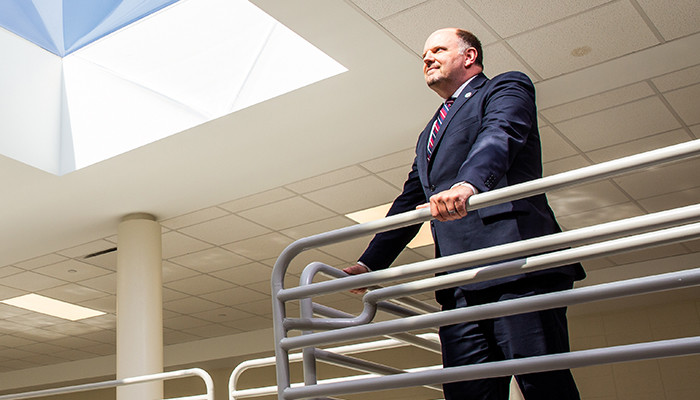When Keith Price became technology director of Alabama’s Vestavia Hills City Schools in 2019, one of the first tasks he tackled was replacing the district’s aging video management system.
The old system was an “antiquated version that didn’t take advantage of modern technology,” Price says.
Now, the district uses an open platform solution from Milestone Systems, which offers more flexibility. The upgrades also include BCDVideo servers and Milestone software.
“We weren’t pinning ourselves to one camera vendor. It really opened us up to have some freedom in the future in adding disparate systems,” Price says. “We also did not have to replace all the cameras in the field, which was a huge cost savings for us.”
Over the years, K–12 security spending has increased as part of fundamental safety efforts as well as in response to violent incidents on school campuses. Even when campuses are empty — on weekends, over seasonal breaks or during social distancing — buildings are targeted for break-ins and vandalism. The growth in spending is expected to continue for the $2.7 billion school security industry through at least 2021, Marketplace reports.
DISCOVER: Download our white paper to learn more about enhanced video surveillance.
In addition to video surveillance cameras, IP cameras, video analytics and related Internet of Things devices can also help school districts manage physical security risks. Another reason for the trend: With falling security camera prices and expanding tools for video surveillance and other physical security needs, K–12 administrators have more options for keeping school buildings — and everyone in them — safe.
The growing emphasis on video feed-based technology, Price says, marks a change in the way districts once approached people gaining access to school grounds.
“Cameras weren’t as big of a deal in terms of recording what was happening on campus,” he says. “How we handle physical security and cataloging what’s going on in schools has changed dramatically in the past 10 years — and will probably continue to do so, based on what we’re seeing.”

When he became technology director in 2019, Keith Price tackled replacing the aging video management system at Vestavia Hills City Schools in Alabama with a more flexible solution. Photography by Caleb Chancey.
Explore More Options, Lower Costs for Cameras
Leon County Schools in Tallahassee, Fla., uses onsite servers such as Dell’s PowerEdge R740xd to store video from its Panasonic security cameras and other IP cameras. The servers are networked to the district security center, and the feed can be viewed through a web-based program, says Robert Tricquet, director of Leon County Schools’ District Security Center.
“That gives us the capability to store video quicker, and it doesn’t take up bandwidth on our network,” says Jim Sciara, the district’s building automation coordinator. “We’re usually running 13 terabytes per site on average, so that gives us a lot of storage.”
Some of LCS’ 2,600 cameras include analog models that were installed years ago. Like some other districts, though, LCS is focusing on installing IP cameras where needed at its 52 sites. Lower camera costs help, Tricquet says.
“Cameras are getting cheaper, and that allows us to do more with them,” he says.
Before investing in new security cameras, administrators should consider what outcomes they’d like to achieve with surveillance, says Guy Grace, steering committee chairman for the Partner Alliance for Safer Schools, an organization that provides security information and tools for school officials and security professionals.
There’s not a one-camera solution for everything, but multiple ones work well together to increase the security and safety of the building.”
Guy Grace
Steering Committee Chairman, Partner Alliance for Safer Schools
Grace is also the director of security and emergency planning at Littleton Public Schools in Colorado. That district uses multipixel cameras that provide clear, high-resolution footage administrators can later zoom in on to examine specific details. If suspicious activity is detected in an area, the cameras send an alert to the district’s security operations center and to Grace’s phone. The district also has thermal imaging cameras that capture activity traditional cameras can’t pick up, such as someone vandalizing an athletic field at night, Grace says.
“There’s not a one-camera solution for everything, but multiple ones work well together to increase the security and safety of the building,” Grace says.
Camera system tools, such as motion detection capabilities that allow viewers to quickly scan footage for movement, can help save time when an incident occurs. The tools also can help cameras integrate with other systems, Grace says.
“The intercom system, the doors, card readers, the mass notification system that allows you to make emergency announcements — all these things are now unified to work in harmony,” Grace says. “Unification to other technologies is so important in allowing school districts to monitor and respond to situations.”
Leon County Schools can share its camera feed with any members of law enforcement who have access to a computer, such as an onboard computer in a patrol car, Tricquet says. In an emergency, “I can bring up the cameras for that site and share real-time videos with about a three-second delay,” he says. Law enforcement “can actually see what they’re getting into before they get there.”


Factor Power and Networking into Security
Cameras aren’t the only type of technology schools are using to enhance safety. For example, Vestavia Hills schools use door access controls at various locations, in addition to Bosch and other video surveillance cameras. Weber School District in Ogden, Utah, has implemented a system that turns Samsung televisions and other screens into digital signage, Technology Director Lynn Raymond says.
“If there’s some type of emergency, we can put a message out and take over all the screens around the whole school to display it,” Raymond says. “We also have an emergency notification system. We use a short code, and it allows us to send out emails or Twitter messages and instantaneously put a message on all of the web pages for the district.”
Security tools deployed can alter schools’ power and connectivity needs. Outlets in older buildings might need to be updated for charging tablets, running projector systems, powering computers in every classroom and enabling other devices, Raymond says.
MORE ON EDTECH: Here what to ask when installing IP video security cameras.
Weber schools have had a local power company add circuits and run additional lines to schools to increase their capabilities. “The electronic circuitry in older buildings was not built with the adequate power you need to run all those systems today,” Raymond says. “Some schools have brick walls and had no room allotted for internal wiring. It can be a real challenge to retrofit a building.”
Schools may be able to work around potential power and other issues. Weber schools reserve wireless connectivity for students’ Google Chromebooks. The district uses point-of-entry switches to power the Axis and other video surveillance cameras — a setup that can also be beneficial for viewing purposes, Raymond says.
“You can usually get a little better feed — a higher resolution — with a wired camera,” he says. “All we have to do is run a network cable to the place where we want a camera, and run it to a point-of-entry switch, which then powers the cameras, as well as tying them into the network.”
Photography by Caleb Chancey












